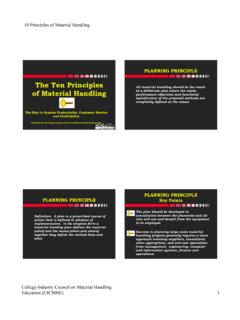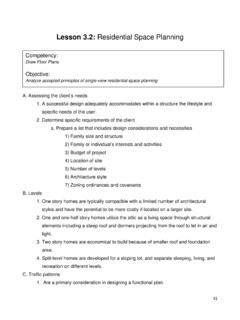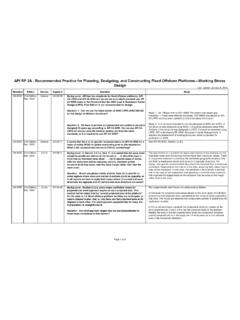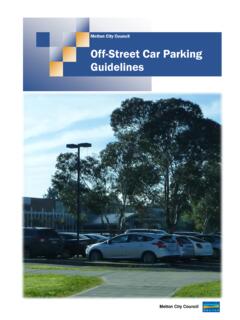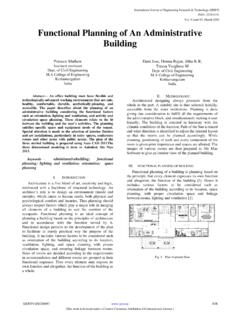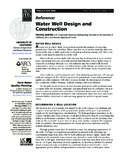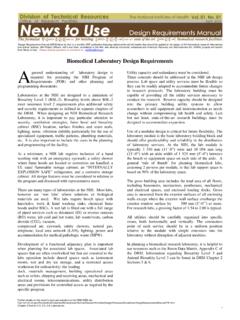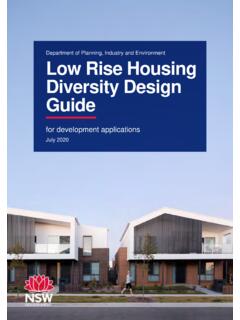Transcription of The Ten Principles of Material Handling
1 10 Principles of Material HandlingCollege-Industry Council on Material Handling Education (CICMHE)1 The Ten Principles of Material Handling The Key to Greater Productivity, Customer Service and ProfitabilityPublished by the College-Industry Council on Material Handling EducationPLANNING PRINCIPLEAll Material Handling should be the result of a deliberate plan where the needs, performance objectives and functional specification of the proposed methods are completely defined at the PRINCIPLED efinition: A plan is a prescribed course of action that is defined in advance of implementation. In its simplest form a Material handing plan defines the Material (what) and the moves (when and where); together they define the method (how and who).
2 PLANNING PRINCIPLEKey PointsThe plan should be developed in consultation between the planner(s) and all who will use and benefit from the equipment to be in planning large scale Material Handling projects generally requires a team approach involving suppliers, consultants when appropriate, and end user specialists from management, engineering, computer and information systems, finance and Principles of Material HandlingCollege-Industry Council on Material Handling Education (CICMHE)2 PLANNING PRINCIPLEKEY POINTSThe Material Handling plan should reflect the strategic objectives of the organization as well as the more immediate plan should document existing methods and problems, physical and economic constraints, and future requirements and PRINCIPLEKEY POINTSThe plan should promote concurrent engineering of product, process design, process layout, and Material Handling methods, as opposed to independent and sequential design PRINCIPLEM aterial Handling methods, equipment.
3 Controls and software should be standardized within the limits of achieving overall performance objectives and without sacrificing needed flexibility , modularity and Definition: Standardization means less variety and customization in the methods and equipment Principles of Material HandlingCollege-Industry Council on Material Handling Education (CICMHE)3 STANDARDIZATION PRINCIPLEKey PointsThe planner should select methods and equipment that can perform a variety of tasks under a variety of operating conditions and in anticipation of changing future applies to sizes of containers and other load forming components as well as operating procedures and PRINCIPLEKey PointsStandardization, flexibility and modularity must not be incompatibleWORK PRINCIPLEM aterial Handling work should be minimized without sacrificing productivity or the level of service required of the PRINCIPLED efinition.
4 The measure of work is Material Handling flow (volume, weight or count per unit of time) multiplied by the distance Principles of Material HandlingCollege-Industry Council on Material Handling Education (CICMHE)4 WORK PRINCIPLEKey PointsSimplifying processes by reducing, combining, shortening or eliminating unnecessary moves will reduce each pickup and set-down, or placing Material in and out of storage , as distinct moves and components of the distance PRINCIPLE Key PointsProcess methods, operation sequences and process/equipment layouts should be prepared that support the work minimization possible.
5 Gravity should be used to move materials or to assist in their movement while respecting consideration of safety and the potential for product PRINCIPLE Key PointsThe shortest distance between two points is a straight PRINCIPLEH uman capabilities and limitations must be recognized and respected in the design of Material Handling tasks and equipment to ensure safe and effective Principles of Material HandlingCollege-Industry Council on Material Handling Education (CICMHE)5 ERGONOMIC PRINCIPLED efinition: Ergonomics is the science that seeks to adapt work or working conditions to suit the abilities of the PRINCIPLEKey PointsEquipment should be selected that eliminates repetitive and strenuous manual labor and which effectively interacts with human operators and ergonomic principle embraces both physical and mental Material Handling workplace and the equipment employed to assist in that work must be designed so they are safe for LOAD PRINCIPLEUnit loads shall be appropriately sized and configured in a way which achieves the Material flow and inventory objectives at each stage in the supply
6 LOAD PRINCIPLED efinition: A unit load is one that can be stored or moved as a single entity at one time, such as a pallet, container or tote, regardless of the number of individual items that make up the Principles of Material HandlingCollege-Industry Council on Material Handling Education (CICMHE)6 UNIT LOAD PRINCIPLEKey PointsLess effort and work is required to collect and move many individual items as a single load than to move many items one at a size and composition may change as Material and product moves through stages of manufacturing and the resulting distribution unit loads are common both pre and post manufacturing in the form of raw materials and finished LOAD PRINCIPLEKey PointsDuring manufacturing, smaller unit loads, including as few as one item.
7 Yield less in-process inventory and shorter item throughput unit loads are consistent with manufacturing strategies that embrace operating objectives such as flexibility, continuous flow and just-in-time LOAD PRINCIPLEKey PointsUnit loads composed of a mix of different items are consistent with just-in-time and/or customized supply strategies so long as item selectivity is not UTILIZATIONE ffective and efficient use must be made of all available Principles of Material HandlingCollege-Industry Council on Material Handling Education (CICMHE)7 SPACE UTILIZATIOND efinition: Space in Material Handling is three dimensional and therefore is counted as cubic UTILIZATIONKey PointsIn work areas, cluttered and unorganized spaces and blocked aisles should be storage areas, the objective of maximizing storage density must be balanced against accessibility and transporting loads within a facility the use of overhead space should be considered as an PRINCIPLEM aterial movement and storage activities should be fully integrated to form a coordinated, operational system which spans receiving, inspection, storage , production, assembly, packaging, unitizing, order selection.
8 Shipping, transportation and the Handling of PRINCIPLED efinition: A system is a collection of interacting and/or interdependent entities that form a unified whole. 10 Principles of Material HandlingCollege-Industry Council on Material Handling Education (CICMHE)8 SYSTEM PRINCIPLEKey PointsSystems integration should encompass the entire supply chain including reverse logistics. It should include suppliers, manufacturers, distributors and levels should be minimized at all stages of production and distribution while respecting considerations of process variability and customer PRINCIPLEKey PointsInformation flow and physical Material flow should be integrated and treated as concurrent activities.
9 Methods should be provided for easily identifying materials and products, for determining their location and status within facilities and within the supply chain and for controlling their PRINCIPLE Key PointsCustomer requirements and expectations regarding quantity, quality, and on-time delivery should be met without PRINCIPLEM aterial Handling operations should be mechanized and/or automated where feasible to improve operational efficiency, increase responsiveness, improve consistency and predictability, decrease operating costs and to eliminate repetitive or potentially unsafe manual Principles of Material HandlingCollege-Industry Council on Material Handling Education (CICMHE)9 AUTOMATION PRINCIPLED efinition: Automation is a technology concerned with the application of electro-mechanical devices, electronics and computer-based systems to operate and control production and service activities.
10 It suggests the linking of multiple mechanical operations to create a system that can be controlled by programmed PRINCIPLEKey PointsPre-existing processes and methods should be simplified and/or re-engineered before any efforts at installing mechanized or automated Material Handling systems should be considered where appropriate for effective integration of Material flow and information PRINCIPLEKey PointsAll items expected to be handled automatically must have features that accommodate mechanized and automated all interface issues as critical to successful automation, including equipment to equipment, equipment to load, equipment to operator, and control PRINCIPLEE nvironmental impact and energy consumption should be considered as criteria when designing or selecting alternative equipment and Material Handling Principles of Material HandlingCollege-Industry Council on Material Handling Education (CICMHE)10 ENVIRONMENTAL PRINCIPLED efinition: Environmental consciousness stems from a desire not to waste natural resources and to predict and eliminate the possible negativ
